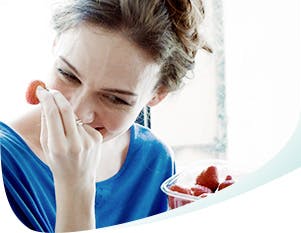How Do I Whiten My Teeth at Home?
While regular brushing and flossing are the best ways to care for your teeth at home, you might feel like your smile could use a little more sparkle. In fact, the most common response from people who were asked what they wished they could improve about their smile was whiter teeth!1
While there are lots of costly procedures for procuring a whiter smile, many people may be wondering how to whiten teeth at home. Learn the facts about why your teeth may become discolored, at-home teeth whitening tips to avoid, and why whitening may not work on all teeth.
Why Teeth Change Color
Over time, your teeth may change from brilliant white to a color that’s less desirable. There are few reasons that this may occur:1
- Your age. Over time, the outer layer of your teeth, called enamel, weakens and becomes thinner. While enamel is naturally white in color, the layer beneath it, the dentin, is yellowish in color. As you age and your enamel thins, the yellow from the dentin becomes more visible.
- Food and drink. Red wine will stain your carpets, your clothes, and your teeth! Coffee, tea, and other foods can stain your teeth as well, thanks to intense color pigments called chromogens that affix themselves to the enamel on your teeth.
- Trauma. If you’ve had an injury or a fall where your teeth were hit, the color of your teeth may change slightly. Your teeth react to injury by creating more dentin, which is darker in color than white enamel top layer.
- Tobacco. Two chemicals in cigarettes can create stains on your teeth: tar and nicotine.
- Medications. Certain antihistamines, blood pressure medication, and antipsychotics can cause tooth darkening. People who are undergoing chemotherapy or radiation may notice that their teeth have darkened as well.
Sometimes it’s a combination of these reasons that can cause your smile to change from white to more of a beige.
Whitening Your Teeth at Home
Before starting any sort of whitening regimen, you should talk to your dentist about your plans for removing stains from your teeth. Not all at-home whitening options will work depending upon the type of discoloration you have.1 Restorations such as veneers, crowns, and fillings won't change color, and teeth that are discolored due to injury or medication may not respond to certain whitening treatments.1 Your dentist can suggest which whitening treatments will work best for you.1 Make sure your dentist approves of your plans for whitening your teeth at home before you get started.
Whitening toothpastes are the most commonly used method of at-home tooth whitening.1 These low-cost products have additional polishing agents that help to remove surface stains.1 After using these products, your teeth may appear whiter because they help scrub stains away.1
Over-the-counter whitening kits are a popular option for many due to their promise to bleach your teeth. However, due to a lower concentration of whitening agents these options may not be as effective as the products supplied by your dentist.1 Some people may experience tooth sensitivity from using these store-bought whiteners due to the peroxide reaching the dentin within the tooth.1 Talk to your dentist if you experience any side effects because of these products.
Your dentist can supply you with a bleaching kit that you can use from your own home.1 You’ll receive a bleaching solution and a tray that should perfectly fit your teeth. The process can take anywhere from a few days to a few weeks but allows you to operate at your own pace.1
Home Tooth-Whitening Remedies to Avoid
It may be tempting to reach for products around your home in order to achieve a whiter, brighter smile. However, these methods that you may read about on social media have little basis in fact and may cause more harm than good.3
A common home remedy for tooth whitening involves lemon juice and baking soda.3 However, this method can wear away your enamel, causing your teeth to appear more yellow than white.
Good oral care begins with brushing twice a day and flossing. Brushing with Pronamel Intensive Enamel Repair Whitening Toothpaste helps to strengthens your enamel and helps restore natural whiteness. If a bright white smile is your goal, consult with your dentist for recommendations based on your individual needs.




